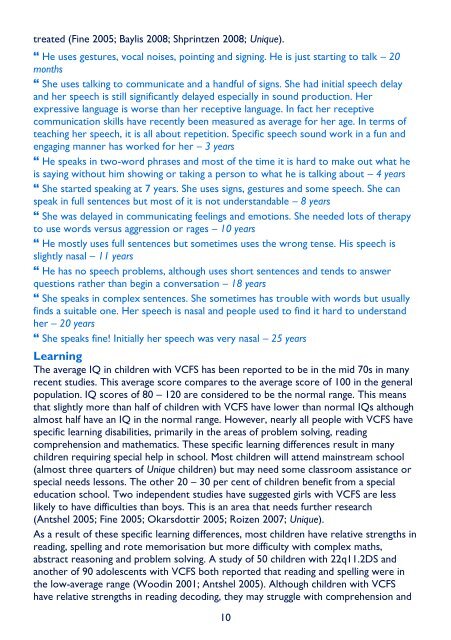Velo-Cardio- Facial Syndrome - Unique - The Rare Chromosome ...
Velo-Cardio- Facial Syndrome - Unique - The Rare Chromosome ...
Velo-Cardio- Facial Syndrome - Unique - The Rare Chromosome ...
You also want an ePaper? Increase the reach of your titles
YUMPU automatically turns print PDFs into web optimized ePapers that Google loves.
treated (Fine 2005; Baylis 2008; Shprintzen 2008; <strong>Unique</strong>).<br />
He uses gestures, vocal noises, pointing and signing. He is just starting to talk – 20<br />
months<br />
She uses talking to communicate and a handful of signs. She had initial speech delay<br />
and her speech is still significantly delayed especially in sound production. Her<br />
expressive language is worse than her receptive language. In fact her receptive<br />
communication skills have recently been measured as average for her age. In terms of<br />
teaching her speech, it is all about repetition. Specific speech sound work in a fun and<br />
engaging manner has worked for her – 3 years<br />
He speaks in two-word phrases and most of the time it is hard to make out what he<br />
is saying without him showing or taking a person to what he is talking about – 4 years<br />
She started speaking at 7 years. She uses signs, gestures and some speech. She can<br />
speak in full sentences but most of it is not understandable – 8 years<br />
She was delayed in communicating feelings and emotions. She needed lots of therapy<br />
to use words versus aggression or rages – 10 years<br />
He mostly uses full sentences but sometimes uses the wrong tense. His speech is<br />
slightly nasal – 11 years<br />
He has no speech problems, although uses short sentences and tends to answer<br />
questions rather than begin a conversation – 18 years<br />
She speaks in complex sentences. She sometimes has trouble with words but usually<br />
finds a suitable one. Her speech is nasal and people used to find it hard to understand<br />
her – 20 years<br />
She speaks fine! Initially her speech was very nasal – 25 years<br />
Learning<br />
<strong>The</strong> average IQ in children with VCFS has been reported to be in the mid 70s in many<br />
recent studies. This average score compares to the average score of 100 in the general<br />
population. IQ scores of 80 – 120 are considered to be the normal range. This means<br />
that slightly more than half of children with VCFS have lower than normal IQs although<br />
almost half have an IQ in the normal range. However, nearly all people with VCFS have<br />
specific learning disabilities, primarily in the areas of problem solving, reading<br />
comprehension and mathematics. <strong>The</strong>se specific learning differences result in many<br />
children requiring special help in school. Most children will attend mainstream school<br />
(almost three quarters of <strong>Unique</strong> children) but may need some classroom assistance or<br />
special needs lessons. <strong>The</strong> other 20 – 30 per cent of children benefit from a special<br />
education school. Two independent studies have suggested girls with VCFS are less<br />
likely to have difficulties than boys. This is an area that needs further research<br />
(Antshel 2005; Fine 2005; Okarsdottir 2005; Roizen 2007; <strong>Unique</strong>).<br />
As a result of these specific learning differences, most children have relative strengths in<br />
reading, spelling and rote memorisation but more difficulty with complex maths,<br />
abstract reasoning and problem solving. A study of 50 children with 22q11.2DS and<br />
another of 90 adolescents with VCFS both reported that reading and spelling were in<br />
the low-average range (Woodin 2001; Antshel 2005). Although children with VCFS<br />
have relative strengths in reading decoding, they may struggle with comprehension and<br />
10

















